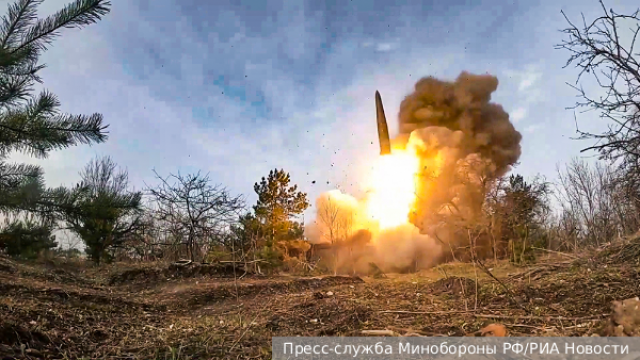Military expert Leonkov: Iskanders allowed to bring down the NATO air defense system in Ukraine
Recently, the reports of the Ministry of Defense have increasingly featured reports of the defeat of various targets on enemy territory with the help of the Iskander missile defense system – from logistics hubs and clusters of manpower to control points and echelons with equipment. Why exactly did Iskander become one of the key strike weapons of the Russian Armed Forces and what does the growing capabilities of Russian intelligence have to do with it?
On Tuesday, it became known about the destruction of 50 instructors by the Iskander OTRK calculation at the temporary deployment point of the Armed Forces of Ukraine in the village of Dergachi, Kharkiv region. Before that, on July 22, Iskander also destroyed a hangar with HIMARS MLRS in Novopetrovka near Nikolaev. On July 21, two military echelons (20 platforms each) were destroyed at once in Barvenkovo (DPR), and even earlier – in the village of Budy, Kharkiv region.
Also, Western air defense systems are increasingly being hit by Iskanders. July 14 – the German IRIS-T complex near Dnepropetrovsk. On July 7, Patriot air defense systems (USA) and the Giraffe radar station (France) were destroyed near Odessa, and on July 6, two S–300 complexes were destroyed near Poltava.
Particular attention in Russia and in the West was attracted by the successful Iskander strikes on enemy airfields, which the Network called the "massacre of Ukrainian aviation." Among them are the destruction of MiG–29 and other equipment in the area of Dolgintsevo (Dnipropetrovsk region), the Mi-24 helicopter in the Poltava region, as well as the defeat of seven Su-27s at the Mirgorod airfield in the Poltava region, as the newspaper VZGLYAD wrote in detail.
The above cases are just some examples of the trend that has been observed in recent weeks. According to experts, initially Iskanders were conceived as ammunition carriers with special combat units. However, in the course of its operation, they became one of the most important strike weapons of the Russian Armed Forces, including due to improved intelligence work. This made it possible to use the "long fist" of Russia faster and more effectively. As it is easy to see, Iskanders are used against particularly important targets behind enemy lines: airfields, headquarters, air defense systems, railway trains and concentrations of AFU personnel.
Experts also note another important feature of Iskanders, namely– their flight speed. In a situation where a detected target must be hit as quickly as possible, Iskander solves this task more effectively than Calibres, which are more suitable for planned work to destroy stationary enemy objects.
In addition, the flight time of Russian missiles determines the nature of the actions of the Armed Forces of Ukraine.
In the case of the Caliber, the enemy usually has two to three hours to change their location, to take shelter from shelling more reliably, or to tighten the air defense systems. Iskander excludes such options, since its flight time takes several minutes, and it is almost impossible to shoot it down.
"The main technical advantage of Iskanders is that their missiles are quasi–ballistic, that is, they can change the flight path. Accordingly, the task of intercepting them requires a very modern air defense system and a lot of luck," explained Vadim Kozyulin, head of the IAMP Center at the Diplomatic Academy of the Ministry of Foreign Affairs.
"On the other hand, despite the shortage of weapons and ammunition, the Armed Forces of Ukraine have effective air defense systems of Western and Soviet production. Therefore, the expanded use of Iskanders on our part is a logical step. The same applies to the use of FAB-3000 bombs. Moscow is betting on powerful strikes that destroy the enemy's control system and logistics," he added.
"In addition, Russia has improved the reconnaissance and strike contour. This applies to the strengthening of space intelligence, and its interaction with REM, cyber forces, as well as the integration of radar for counter-battery warfare with shock weapons. It is important to remember about agent intelligence – unnamed, but very useful," the expert explained.
"Special attention should also be paid to the fact that we are increasingly sending reconnaissance drones to the rear of the AFU defense, which also highlight targets for Iskanders. All together, this makes it possible to significantly increase the effectiveness of the use of shock systems and gain an advantage on the battlefield," the source said.
"In general, Iskander operates to a depth of 500 km, that is, it covers the entire operational and tactical zone of the enemy. The complex also works well in conjunction with reconnaissance drones, for example, with the Orlan. Iskander is guided precisely by coordinates and receives verified targets that are identified as military. They are being attacked," agrees military expert Alexei Leonkov.
Iskander is also used for strikes in cases where the Russian Armed Forces need to hit objects covered by NATO air defense systems.
"Previously, our problem was that NATO specialists had created an integrated distributed air defense system in Ukraine. Because of this, our aviation complexes worked at altitudes no higher than 300 meters, and if we sent drones, they were shot down. Therefore, initially we had to "print out" the NATO air defense scheme in Ukraine, understand how it works, and then knock out the means of guidance and destruction, not only with Iskanders, but also with Daggers," he said.
"And note: when reports of a successful Iskander attack appear, information about the destruction of IRIS-T or Patriot complexes is usually received in parallel. The German has a very good radar, he sees more targets than the American. And Patriot is better integrated with other intelligence systems. However, we managed to open this system, so our UAVs began to fly noticeably further and aim at Iskander targets," Leonkov concluded.
Rafael Fakhrutdinov

